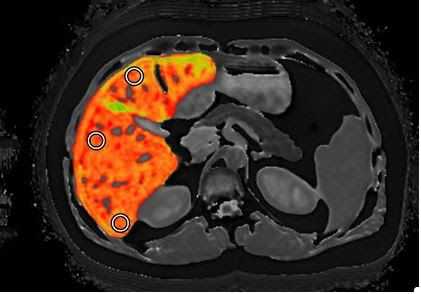I wonder who the last person to learn that they have cirrhosis following unrelated surgery will be? The problem of diagnosing liver disease during surgery must become a thing of the past. Routine screening and non-invasive testing is the key to eliminating this devastating situation.
I'll explain this below, but I just had my first LiverMultiScan by Perspectum (click this link to learn about it) and this image is a key part of my personal report. This part of the test measures inflammation and indicates that I have almost no active inflammation in my liver which pleases me. That indicates that my disease is not progressing. I am apparently not making new fibrosis scars and that is a win for a cirrhosis patient.
A more typical scan of someone with serious liver disease would look like this.
I'm particularly pleased that I have been able to manage my stage 4 NASH through diet and exercise.
It is important to understand what this test isn't. It is done using an MRI but the image it produces is not the normal MRI image. The MRI readings are sent to an artificial intelligence program which looks for all liver cells. It then applies its measurements to those cells so it is processing a selected subset of the tissue. This is unlike a regular MRI which shows all of the tissue that it can get a response from so while the display looks like a typical MRI it is actually measuring a very specific cell population with a goal of determining how much inflammation is affecting those liver cells.
Another part of the test measures liver fat using PDFF and I have less than 1% fat in my liver. These two measurements are important to me but one thing that is not measured is liver stiffness. The test tells me important things about the current activity in my liver but it still doesn't include a measure of how much damage has been done. I'm very pleased to see that my lifestyle changes are working for me so far but like all tests there are still other things that are important to truly understand the situation. We also have to remember that all tests have a margin for error. This test's accuracy is similar to biopsy but nothing is perfect.
My path to diagnosis was a common one including gallbladder surgery. It is not acceptable that the first time many patients learn about liver disease is when they are told that they have stage 4 cirrhosis. A medical system that chooses not to identify a deadly disease process decades in the making does not truly have patient wellness as a core value. Common reasons given for why liver disease is ignored is that we have had neither tests nor drugs to deal with it so no reason to be aware. That situation is changing and we must insist that the medical community respond to the rapidly increasing problem of chronic illness, and liver disease is a central player.
We all want to move beyond the current situation and non-invasive testing is advancing rapidly. I've commented on blood tests such as NIS4 and LIVERFASt in earlier blogs and we have been advocates for FIB-4 for years. We have used FibroScan in our SUNN study and I've reported my personal experience with MRE.There are other tests in the market and many in development and I'm confident that diagnosis by surgery will go away and biopsy will become needed for only special cases.
CMS recently approved the Perspectum LiverMultiScan for payment under Medicare and private insurers are also beginning to cover it. Until now it has been largely a tool of the research community but will now be one of the diagnostic tools available to the general population.
The next test that I want to get is a current measure of my liver stiffness. Long time followers know that when diagnosed my FibroScan reading was 21.5. About a year ago it was 9.6. As I get older it is important to me to understand if that is changing. In my ideal world my liver will continue to absorb that scar tissue and my liver will improve. Getting older and things like infections work against me and can cause increased damage and as part of managing my disease it is important to me to know what is happening over time.
On a more public note, we have launched an important program and I need your support.
The Fatty Liver Foundation has undertaken a patient focused survey to gather baseline data that many people can use to support advocacy and measure change. This will be an annual study of the broad fatty liver patient population.
I know, we all get so many requests for surveys and opinion polls and it is a big pain to even have to delete them. I hope that since this request is by patients for patients and we are not trying to sell you something or to get you to participate in some program, that you will give us a bit of your time.
When you are dying slowly of chronic disease the system doesn't care much. There is no lobbyist for you. The money train doesn't run for you. Come back when you are a proper billable code. Even if you have finally arrived as a properly billable item, does the system treat you as something important or push you through the grinder?
In many ways the periods before and between the acute events that medicine cares about are the most difficult. The seemingly endless hours of being unwell are the things that healthcare decision makers, who are not yet themselves suffering, seem not to concern themselves with.
We argue for early detection and wellness to be the goals but our system rewards heroic intervention instead. There is talk of wellness and like all things touched by politics and power it isn't the patient's success that really drives decisions. The Care Survey is one step to fight against that.










